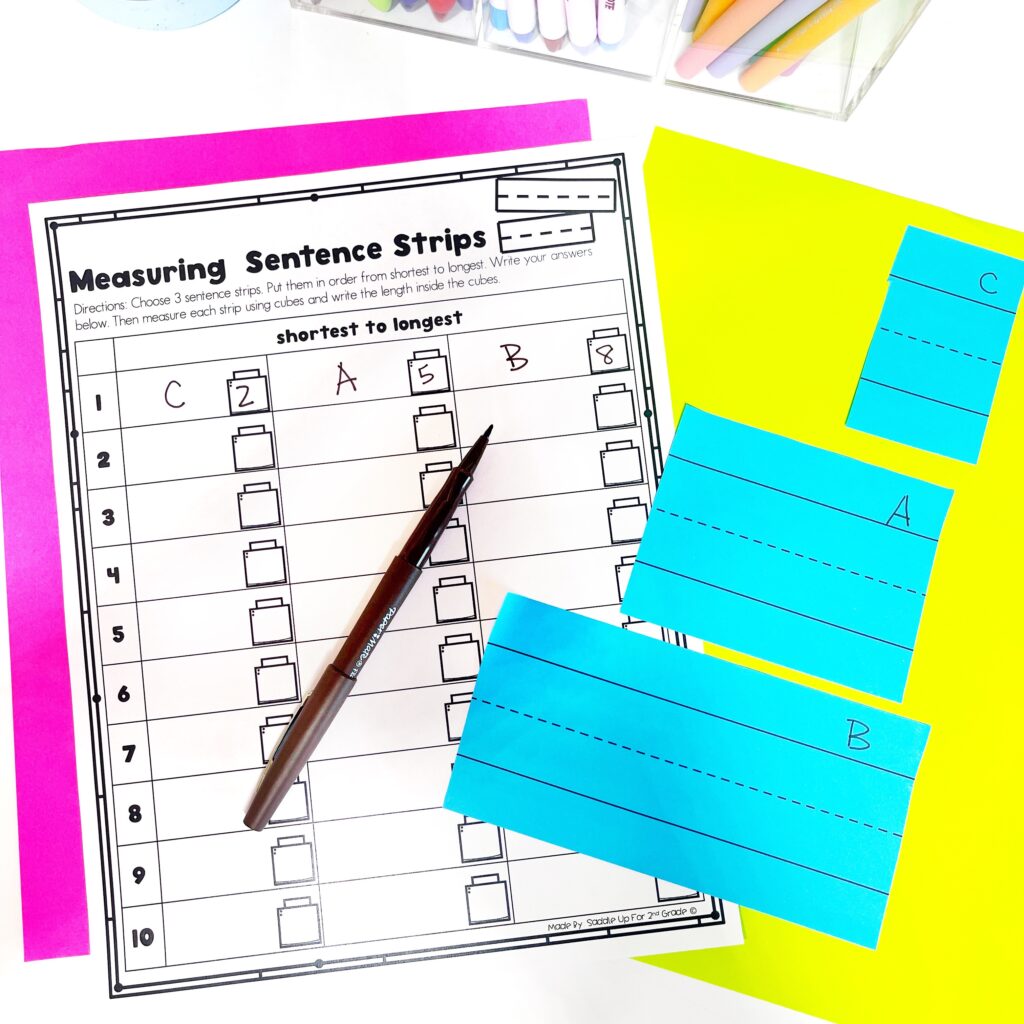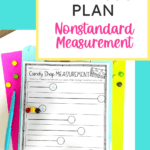

Join me for a FREE, Guided Math workshop to discover how to easily incorporate Guided Math into your current schedule!
Are you teaching nonstandard units of measurement in 1st grade? There are so many hands-on ways to do this. If you’re looking to spice up your math lessons and make teaching measurement fun, read on for 8 kid-friendly nonstandard measurement activities that you can incorporate into your classroom! Plus, you can grab a FREE sample measurement lesson plan from my 1st Grade Nonstandard Measurement Guided Math Unit. Let’s dive in!

In 1st grade, students learn all about nonstandard units of measurement, comparing measurements, and expressing different lengths and heights. The world of nonstandard units of measurement is an exciting one for students to dive into with so many possibilities. There are a ton of real-world connections that can be made when teaching this skill, making it that much more fun to experiment with.
Check out my YouTube video below for a complete walkthrough of a full guided math lesson covering nonstandard measurement using one of my favorite nonstandard measurement tools… Skittles!
Standard and nonstandard measurement are two different approaches to measure objects. When you think of measurement, you likely think of rulers and yardsticks that measure centimeters, inches, feet, and yards, which are standard measurement units. However, nonstandard units of measurement are a bit different.
Nonstandard units of measurement are tools of varying sizes that can be used to measure the length, width, or height of an object. This approach encourages creativity and exploration in measurement and helps students develop a deeper understanding of the concept.
What makes nonstandard measurement such an explorative concept is the amount of nonstandard measurement tools that can be used to measure and compare different objects.
Some examples of nonstandard units of measurement are:
When first introducing nonstandard measurement in 1st grade, I recommend creating a nonstandard measurement anchor chart together as a whole class. This allows students to learn the rules of nonstandard measurement, how it differs from standard measurement, and brainstorm various nonstandard units that they can use to explore with.
As you create the whole group nonstandard measurement anchor chart, have your students create a mini-version of the same anchor chart in their math journals. This allows them to always have it to reference during independent work and helps them grasp the new concept being taught.


First, when introducing and modeling nonstandard units of measurement, make sure to emphasize the importance of using the same unit as your measurement tool and in the same size. You don’t want to measure the same object with both a unifix cube and a Skittle, or a long paper clip and short paper clip.
Next, always start at the edge of the object and measure to the end. The third step is making sure you have no gaps or overlaps with your measurement tools. Model and show students what this looks like. As you are providing examples throughout your unit, model it incorrectly sometimes and let your students catch your mistakes. They’ll think it’s so fun to correct the teacher, and it really makes them think critically and pay attention.
Lastly, make sure to measure with your nonstandard units (AKA, your measuring tools) in a straight line. You don’t want your tools to be wonky and uneven, because then your measurements won’t turn out right. Again, model both correctly and incorrectly for your students.
This Toolbox Measurement activity is a great way to practice this concept and process during your introductory lesson.

As I mentioned, there are so many hands-on ways to practice nonstandard units of measurement. Check out these 8 kid-friendly activities that you can incorporate into your lessons right away!
The first nonstandard measurement activity is called Measuring My Foot. Students will first trace their foot onto construction paper and cut it out. They’ll estimate the length of their foot and then measure it using paper clips or unifix cubes to see how close they were. They can also trade feet and guess and measure their friends’ foot cut-outs. This activity is also found in my 2nd grade measurement unit.

For this nonstandard measurement activity, students will simply need pipe cleaners, paper clips, and unifix cubes, but you could adapt this using any materials you already have in your classroom. Students will estimate the length of the pipe cleaner and measure each one first with the paper clips and second with the unifix cubes. They’ll record their data on the Measuring Pipe Cleaners sheet and repeat with a different length of pipe cleaner. This activity can be found in my 2nd grade measurement unit as well as in the free measurement lesson for 1st grade (which you can grab below in this blog post).

One of my favorite nonstandard units to use as tools with my students is candy. Let’s be honest, kids will do anything for Skittles, which is exactly what we use in this Candy Measurement activity! Students will practice measuring lines of various lengths with nonstandard measurement using Skittles (or you can use M&Ms or another candy you have on hand!).

This activity is also found in the free measurement lesson for 1st grade, which you can grab below! Simply fill out the form and it’ll be delivered straight to your inbox!
Another simple and fun way to practice nonstandard measurement is with sentence strips. In this Measuring Sentence Strips activity, students will choose 3 sentence strips and put them in order from shortest to longest. They’ll measure each strip using unifix cubes and record the length inside the cubes on the recording sheet.

Tool Measurements is a great way to help students practice measuring objects of different shapes and sizes while also making math-to-world connections. Students will measure each tool and then answer questions to compare the measurements and analyze the data found.

Measurement City is super fun and is one of my favorite nonstandard measurement activities! Students will color each building a different color and order them from shortest to tallest. Then, they’ll use unifix cubes to measure each building and record their measurements. They’ll use their findings to answer questions about the data and compare measurements.

If you need a good way to hook your students into a lesson, race cars are sure to do it! Race and Measure is a highly engaging activity where students will race their cars and measure the length they traveled using unifix cubes. Students will grab a partner to complete this activity, or they can find a new partner for each race.

The last of the nonstandard measurement activities is a Rainbow Measurement Craft. I love wrapping up my guided math units with a math craft that allows students to show what they know in a fun way. Students will get various rainbow pieces in different colors to measure with both unifix cubes and paper clips. They’ll write the length and then attach the rainbow strips to the cloud to complete their craft.

I hope you enjoyed learning more about nonstandard units of measurement and some fun, simple, and effective ways to practice it with your students! You can find all of these activities and more in the guided math units below or in my TPT store!
Don’t forget to fill out the form in the middle of this post to get your free 1st grade measurement guided math lesson plan!

Math should be fun, not stressful. Ditch the timed math fact tests and replace them with math games that will help your students learn and retain information more effectively.
© Saddle Up for 2nd Grade • Website by KristenDoyle.co


